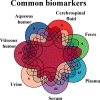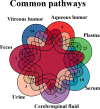Metabolomics of various samples advancing biomarker discovery and pathogenesis elucidation for diabetic retinopathy
- PMID: 36387907
- PMCID: PMC9646596
- DOI: 10.3389/fendo.2022.1037164
Metabolomics of various samples advancing biomarker discovery and pathogenesis elucidation for diabetic retinopathy
Abstract
Diabetic retinopathy (DR) is a universal microvascular complication of diabetes mellitus (DM), which is the main reason for global sight damage/loss in middle-aged and/or older people. Current clinical analyses, like hemoglobin A1c, possess some importance as prognostic indicators for DR severity, but no effective circulating biomarkers are used for DR in the clinic currently, and studies on the latent pathophysiology remain lacking. Recent developments in omics, especially metabolomics, continue to disclose novel potential biomarkers in several fields, including but not limited to DR. Therefore, based on the overview of metabolomics, we reviewed progress in analytical technology of metabolomics, the prominent roles and the current status of biomarkers in DR, and the update of potential biomarkers in various DR-related samples via metabolomics, including tear as well as vitreous humor, aqueous humor, retina, plasma, serum, cerebrospinal fluid, urine, and feces. In this review, we underscored the in-depth analysis and elucidation of the common biomarkers in different biological samples based on integrated results, namely, alanine, lactate, and glutamine. Alanine may participate in and regulate glucose metabolism through stimulating N-methyl-D-aspartate receptors and subsequently suppressing insulin secretion, which is the potential pathogenesis of DR. Abnormal lactate could cause extensive oxidative stress and neuroinflammation, eventually leading to retinal hypoxia and metabolic dysfunction; on the other hand, high-level lactate may damage the structure and function of the retinal endothelial cell barrier via the G protein-coupled receptor 81. Abnormal glutamine indicates a disturbance of glutamate recycling, which may affect the activation of Müller cells and proliferation via the PPP1CA-YAP-GS-Gln-mTORC1 pathway.
Keywords: alanine; biomarker; diabetic retinopathy; glutamine; lactate; metabolomics; pathogenesis.
Copyright © 2022 Du, Yang, Kong, Sun, Shen, Cai, Sun, Zhang, Guo, Zhang and Wang.
Conflict of interest statement
The authors declare that the research was conducted in the absence of any commercial or financial relationships that could be construed as a potential conflict of interest.
Figures











Similar articles
-
PPP1CA/YAP/GS/Gln/mTORC1 pathway activates retinal Müller cells during diabetic retinopathy.Exp Eye Res. 2021 Sep;210:108703. doi: 10.1016/j.exer.2021.108703. Epub 2021 Jul 17. Exp Eye Res. 2021. PMID: 34280391
-
Metabolic characterization of diabetic retinopathy: An 1H-NMR-based metabolomic approach using human aqueous humor.J Pharm Biomed Anal. 2019 Sep 10;174:414-421. doi: 10.1016/j.jpba.2019.06.013. Epub 2019 Jun 10. J Pharm Biomed Anal. 2019. PMID: 31212142
-
Serum Untargeted Metabolomics Reveal Potential Biomarkers of Progression of Diabetic Retinopathy in Asians.Front Mol Biosci. 2022 Jun 9;9:871291. doi: 10.3389/fmolb.2022.871291. eCollection 2022. Front Mol Biosci. 2022. PMID: 35755823 Free PMC article.
-
Metabolomics in Diabetic Retinopathy: From Potential Biomarkers to Molecular Basis of Oxidative Stress.Cells. 2022 Sep 26;11(19):3005. doi: 10.3390/cells11193005. Cells. 2022. PMID: 36230967 Free PMC article. Review.
-
Metabolomics in Diabetic Retinopathy: A Systematic Review.Invest Ophthalmol Vis Sci. 2021 Aug 2;62(10):4. doi: 10.1167/iovs.62.10.4. Invest Ophthalmol Vis Sci. 2021. PMID: 34347011 Free PMC article.
Cited by
-
Serum metabolomics signature of maternally inherited diabetes and deafness by gas chromatography-time of flight mass spectrometry.J Diabetes Investig. 2025 Jan;16(1):146-153. doi: 10.1111/jdi.14334. Epub 2024 Oct 31. J Diabetes Investig. 2025. PMID: 39480690 Free PMC article.
-
Revolutionary Point-of-Care Wearable Diagnostics for Early Disease Detection and Biomarker Discovery through Intelligent Technologies.Adv Sci (Weinh). 2024 Sep;11(36):e2400595. doi: 10.1002/advs.202400595. Epub 2024 Jul 3. Adv Sci (Weinh). 2024. PMID: 38958517 Free PMC article. Review.
-
Metabolomics of ocular immune diseases.Metabolomics. 2025 Jun 2;21(3):74. doi: 10.1007/s11306-025-02273-9. Metabolomics. 2025. PMID: 40457094 Free PMC article. Review.
-
Metabolites as Risk Factors for Diabetic Retinopathy in Patients With Type 2 Diabetes: A 12-Year Follow-up Study.J Clin Endocrinol Metab. 2023 Dec 21;109(1):100-106. doi: 10.1210/clinem/dgad452. J Clin Endocrinol Metab. 2023. PMID: 37560996 Free PMC article.
-
The immune-related plasma protein LAT2 as a protective modulator in diabetic retinopathy: a Mendelian randomization study.Front Endocrinol (Lausanne). 2025 Jul 17;16:1638661. doi: 10.3389/fendo.2025.1638661. eCollection 2025. Front Endocrinol (Lausanne). 2025. PMID: 40747309 Free PMC article.
References
Publication types
MeSH terms
Substances
LinkOut - more resources
Full Text Sources
Medical

